This January and February, we’ll be finishing up our look at the second season of Star Trek: The Next Generation and moving on to the third year of the show, both recently and lovingly remastered for high definition. Check back daily for the latest review.
The Best of Both Worlds, Part II was always going to feel like a bit of an anti-climax. After all, the show had spent so much time building up the Borg as this implacable and undefeatable adversary. In Q Who?, it had taken the interference of a god-like entity to allow the Enterprise a chance to escape their unstoppable foe. In The Best of Both Worlds, Part I, the Enterprise had been able to run for a while – but the Borg eventually caught up with them and took what they wanted.
Since The Best of Both Worlds, Part II was never going to end with the Borg destroying Earth, and since Star Trek: The Next Generation was never going to be a show willing to exact a dramatic cost high enough to justify victory against such overwhelming odds, the resolution to the two-parter was never going to live up to the heightened drama and impossible stakes suggested by The Best of Both Worlds, Part I.
Still, the second part of the adventure is charming and exciting enough that it never completely falls apart. While the resolution to the crisis does seem a little trite and convenient, The Best of Both Worlds hangs together as the show’s best two-part adventure until at least Chain of Command in the sixth season.
Of course, by just about every conceivable measure, The Best of Both Worlds was a success. There’s a reason that season-ending cliffhangers became the default setting for the Star Trek spin-offs, even if Redemption, Time’s Arrow and Descent could never quite measure up to the power (or pop culture impact) of The Best of Both Worlds. Star Trek: Voyager and Star Trek: Enterprise also adopted this model. Even when Star Trek: Deep Space Nine eschewed the two-part format, it still made a point to close the season on a radical shift in the status quo that had to be explored in the first episode of the next season.
People tuned in to watch, and The Best of Both Worlds really catapulted The Next Generation to the forefront of public consciousness. It never quite got the mainstream attention or credit that it deserved, but there’s no doubt that the success of The Best of Both Worlds played a pretty significant role in earning the consolation Outstanding Drama Series nomination the show finally earned in its final year on television. It’s still something of a highlight for the show, and was a big enough deal that its high-definition remastering saw both a separate blu ray release and a theatrical screening.
So while the second part might not quite measure up to the first part of the story, it’s important to keep things in perspective. The Next Generation would develop something of a problem when it came to structuring two-part episodes. Paying never seemed quite as satisfying as setting up. Certainly, the consistency of both parts of The Best of Both Worlds is significantly higher than the consistency of Redemption or Descent.
Indeed, later two-parters would figure out this difficulty with dramatic pay-off and try to circumvent it by structuring the two parter as two distinct halves. Birthright, for example, is one story – but the two halves are distinct from one another. Data’s subplot and the presence of Deep Space Nine are restricted to the first half, while Worf’s difficulties with the former prison colony only really get to pay-off during the second-half. Similarly, the torture of Jean-Luc Picard is mainly restricted to the second half of Chain of Command, with the first part more interested in the covert mission and the shake-up to the Enterprise crew.
The Best of Both Worlds feels like one story. The two-part episode fits together into a movie-length adventure quite well, even if the cliffhanger doesn’t quite work as an act break in a longer episode. All the dramatic threads that begin in the first half flow through to the second. The second picks up the ball and runs with the same dramatic tension. Sure, there are some continuity gaffes created by the several months that have passed since Riker gave the order to fire, but The Best of Both Worlds has an internal tightness that holds together quite well.
And the opening few acts of the second park work. It’s really impossible to ratchet up the tension past the climax of the first episode, but Michael Piller’s conclusion makes a pretty legitimate attempt. The Enterprise’s weapons are useless against the Borg cube. The Borg ship takes off with the Enterprise unable to give proper chase. When the Enterprise arrives at the site of the Federation’s last stand… it discovers only a haunting graveyard of Federation vessels. The Borg carve their way towards Earth, hovering menacingly over the planet…
And then the story has to resolve itself. It is, to be fair, a problem that Michael Piller has been quite candid about. Piller had originally planned to leave at the end of the third season, and Riker’s issues in The Best of Both Worlds were somewhat auto-biographical. Part of the reason Piller felt so free to write the show into a corner was because he thought he wouldn’t have to write the series out of it, as he confessed to Starlog:
When I started writing [The Best of Both Worlds], I wasn’t planning to come back the following year, so all I had to do was write Part One, and it would be somebody else’s problem to write Part Two. Of course, we had no idea how successful the third season would be, because it takes time for [a series’] impact to show up.
…
And then Gene came in while the season was winding down, and said “Listen, the series needs one more year to really catch on, and I would like you to return.” With that in mind, I was forced to go back and write Part Two. I didn’t even know how I was going to get our people out of this disaster.
So it’s understandable that the conclusion might not match the set-up. After all, Piller hadn’t been worried about wrapping the story up when he sat down to start telling it.
In an interview with Cinefantastique, future staff writer Brannon Braga gives an insight into that creative process:
Moore’s fellow producer and frequent writing partner, Brannon Braga, came on the show during the hiatus between the third and fourth seasons. “I walked into the Hart building in the morning and Michael Piller was rewriting ‘Best Of Both Worlds, Part II,'” recalled Braga. “He introduced himself and said ‘I’m trying to figure out how to beat the Borg. I have no idea how to do it.’ At that time the only other staff writer here was Ronald Moore, because the older writing staff — [Melinda] Snodgrass and Ira [Steven Behr] and everyone — was leaving.”
To be fair, there really weren’t too many options open to Piller to conclude the story. It had been made quite clear that the Borg could not be overwhelmed by brute strength. Using a deus ex machina like Q or the nanites would feel like a cheap cop out.
The Borg had to be outwitted, but the Enterprise also had to find and exploit a key weakness that would underscore why our heroes were inherently superior to their latest (and arguably greatest) adversaries. Given that the Borg were presented as a collective with no regard for their individual members, it’s only appropriate that the Enterprise exploits this defeat them. Riker and his crew abduct Locutus and then the Borg just carry on without him, acknowledging that any philosophy so casual about the loss of a single individual cannot be triumphant.
Of course, there’s a bit of a logical problem here. While the Borg are a collective that do not care about their individual members, the whole point of The Best of Both Worlds is that Locutus has been assimilated as a bridge between the Federation and the Borg. He is, by his nature, more important than an average drone. He has been assimilated specifically to facilitate the invasion of Earth. So the Borg’s decision to just carry on without him seems a bit surreal.
Sure, you can handwave it away. Maybe they had already got everything they needed from Picard, and had drained his insight and intellect. It’s not a fatal or inexcusable flaw by any means, but it does seem a little strange. Similarly, the logic of the final defeat of the Borg is also a bit fuzzy. Using the “sleep” command to stop the cube is fair game. It seems weird that the collective considers the imperative to go into stand by mode as a “low priority system”, but it’s not unreasonable. However, how putting the Borg into “sleep” mode leads to a dramatic climactic explosion is somewhat hazy.
Again, it’s hardly something that completely undermines the episode. It’s easy enough to justify that with some vague pseudo-sci-fi metaphor. Kinda like over-charging your phone battery actually makes deplete quicker, but with explosions! And it makes sense from a storytelling point of view. “Borg just stop” is a reasonably satisfying ending. “Borg stop and then explode” is a much more satisfying bombastic conclusion to the adventure, and arguably much more satisfying from the point of view of a self-contained adventure.
(If The Next Generation were serialised, exploring a sleeping Borg cube later in the season might be fun, but the show is episodic. The Next Generation Companion suggests that Piller originally wanted to write a Borg trilogy, so the idea of a cube just hanging above Earth, snoozing, is pretty exciting from a long-term storytelling perspective. Unfortunately, we’re not quite there yet. Still, the next episode to air is Family, so it’s hard to feel too hard done by.)
The episode’s conclusion does check all the necessary dramatic boxes, in terms of over-arching themes and the restrictions on The Next Generation as a syndicated science-fiction drama. It just can’t help but feel a little underwhelming. The first two Borg episodes ending with the Enterprise manoeuvred into a corner, so writing a mostly-satisfying conclusion to this two-parter was an almost impossible task. It feels a bit much to complain that Piller can’t match the quality of the first part.
There are some other interesting aspects to The Best of Both Worlds. Most notably, Shelby is fairly quickly sidelined and integrated into the cast here. She spent so much of the first part giving Riker a kick up the backside and providing tension and conflict, it feels weird that she slots so easily into the ship’s command crew. Indeed, Shelby seems to exist in the second part primarily as a stop-gap; she slots right below Riker on the totem poll, so Picard’s abduction doesn’t affect the crew roster or status quo in a meaningful way.
It’s a bit of a shame, as Shelby was a really compelling character in the first part. She was ambitious and aggressive, in a way that most Starfleet officers weren’t allowed to be, but in a way that made sense in context. After all, people don’t get to be captains by blending effortlessly into the machinery. Some measure of ambition and pride is a good thing. Putting Shelby on the ship drew a nice contrast with Riker, a character who was repeatedly and frequently described as “ambitious” by other characters, but who often seemed like he’d settled in quite snugly.
Shelby is also notable as a rare female Starfleet officer on The Next Generation who is portrayed outside gender roles. Troi and Crusher are both defined as female “care-givers.” As awesome as Tasha Yar was in concept, far too much of the first season was preoccupied with how Yar really just wanted to be properly girly, particularly episodes like The Naked Now and Code of Honour, as if it was impossible for a woman to retain her femininity while serving as Chief of Security.
Shelby is, at least in theory, somewhat free of those constraints. We’re spared scenes of her talking to Troi about how sexy Troi gets to be, or awkward psycho-babble about how she really just needs a strong man to dominate here. (Yeah, early episodes of The Next Generation have serious issues. But let’s not get back into that.) Instead, Shelby is a woman who has been recruited to do a job and sets about doing it to the best of her ability.
It’s no wonder that there was apparently gossip about Shelby joining the cast in the fourth season. Although it would have been quite hard to slot her into the roster, it would have done a lot to help remedy some of the show’s gender issues. To be fair, the show was trying to work on this problem, as The Next Generation Companion notes:
Despite the rumours over the summer, the talk about making the strong-willed Shelby a regular in the wake of Wesley’s upcoming exit eventually evaporated. A succession of female conn officers would follow until the the semi-regular Ensign Ro came aboard in the fifth season in an episode named for her. Meanwhile, amid all the swashbuckling, hand it to the women of this crew for saving humanity: it is Beverly who discovers the Borg’s fatal flaw, and it’s Troi who realises that Picard is fighting through his programming.
While this is a nice idea in principle, it can’t help but feel a little shallow. It isn’t Crusher who discovers the fatal flaw. In fact, Crusher is too caught up in her stereotypical gendered care-giver role to make the connection when Picard suggests “sleep.” Crusher remarks, “He’s exhausted.” It’s Data who makes the logical leap necessary to save the day. “Yes, Doctor, but if I may make a supposition, I do not believe his message was intended to express fatigue but to suggest a course of action.”
Even Shelby is introduced as a sexualised object in conversation between Picard and Admiral Hanson. When Picard notes how “taken” his old friend seems with the young woman, Hansen responds that it’s just “an old man’s fantasy.” Because there’s no way he could respect her as a fellow officer or even in a paternal manner. There absolutely has to be some sexual element to an ambitious young female officer with a respected elder mentor.
To the credit of Piller, this is really the only time where Shelby is sexualised. For all her tension with Riker, there’s never any serious indication of a romantic or sexual dimension to their chemistry. They part on good terms, but as platonic friends. And it is worth noting that Shelby is probably the most compelling female Starfleet officer that will appear until Ro Laren in Ensign Ro, more than a year away at this point.
It is worth noting that Shelby divides fan response. Like far too many cult fandoms, science-fiction fandom is often a horrifying misogynistic place. So it’s interesting to note the response that actress Elizabeth Dennehy often gets from fans:
I liked that she didn’t let the protocol get in the way of doing the job. She didn’t care about diplomacy. She saw what she had to do and wasn’t going to let anyone stop her from solving the problem that she was brought on board to solve. Some people come up to me at conventions and say, “Oh, you were such a b!tch.” I couldn’t play her like that. I had to see her side, and her side was, “You have a problem and I’m here to solve it.” And… she was right. So I always look at Shelby as the kid in school who got straight A’s, had her arm in the air and was saying, “Pick me, pick me!” She knew all the answers and didn’t care if people resented her for it.
Describing a female character as a “b!tch” for presuming to challenge the male main character feels a little excessive. Particularly when, as Dennehy notes, many of her comments and her outlook turn out to be correct.
This is something that the episode is quite careful to make clear – that Shelby isn’t so much an outsider as a flashback to a younger William Riker. In conversation with Troi in the first episode, Riker explicitly states that she has the same attitude and outlook that he used to have, and yet Riker’s stand-off-ish jerkishness in early episodes never provoked the same sort of response from fans. In fact, Riker himself seems to admire those attributes. “I look at her and I wonder whatever happened to those things in me? I liked those things about me.”
It is worrying that Shelby tends to generate that sort of reactionary knee-jerk response from fans of what should be a progressive science-fiction show. Of course, there are quite a few examples of the fans reacting in a surprisingly close-minded manner to challenging aspects of the series. The fans reacting this way towards Shelby are undoubtedly a minority, but the fact that Dennehy hears “oh, you were such a b!tch!” often enough to repeat it several times anecdotally in discussion of her two-episode appearance is really something that deserves to be discussed in the context of The Next Generation‘s gender roles.
While The Best of Both Worlds does subvert a lot of the gender stereotypes that The Next Generation takes for granted, Brian L. Ott and Eric Aoki argue in Popular Imagination and Identity Politics: Reading the Future in Star Trek: The Next Generation that it is not as ideal as it might seem:
There are several instances where this hierarchy is turned on its head, however. The classic two-part episode, The Best of Both Worlds, in which the Enteprrise and humanity must battle a cybernetic collective known as the Borg is a prime example. In this episode, nearly every idea and action that favours the Enterprise originates with a female character – Crusher, Troi, Guinan (Whoopi Goldberg), or Shelby (Elizabeth Dennehy). When Captain Picard is abducted by the Borg, the first officer Riker is quickly feminised in relation to the ambitious, quick-witted, and hypermasculine Shelby, Starfleet’s “best tactician.” Ultimately, Riker’s more ‘feminine’ approach, involving collaboration, proves to be more productive than Shelby’s competitive approach. Though TNG appears to equivocate on the matter of gender roles in this episode, traditional gender roles are reversed, not ruptured. The series continues to construct them as a mutually exclusive categories and when the ‘feminine’ category is finally the more valued one, a male character is enacting it.
Still, while it’s not perfect – and it’s far from nuanced – it does feel like The Next Generation is at least trying to do a better job writing its female characters. The results don’t always turn out as well as one might hope, but there’s a sense that Piller and the writers are at least trying to be mindful.
So, for example, the fourth season gives us episodes making use of Troi and Crusher without tacking on a romance. Picard’s romance with the proactive Vash returns, and Vash rejects our dynamic leading man. The show doesn’t always succeed at doing this, but it’s clear that Michael Piller has recognised a lingering weakness in the show and is making very conscious and careful attempt to correct it.
Outside of all this, The Best of Both Worlds, Part II also offers an interesting glimpse into the relationship between Guinan and Picard. Guinan is a character who is so mysterious that she’s often downright frustrating. The nature of her relationship to Picard is something that remained fairly ambiguous, even after Time’s Arrow cleared it up just a little bit. All we really know is that the relationship is pretty deep. In Yesterday’s Enterprise, Picard was ready to re-write history as he knew it on Guinan’s recommendation.
Here, the show offers a more explicit statement about the nature of the bond between the captain and his barkeep. It’s nothing affirmative, but it does give us a sense of scope by explicitly identifying what it isn’t (or, at the very least, what it is greater than). “Did he ever tell you why we’re so close?” Guinan asks Riker. “Well, then let me just our relationship is beyond friendship, beyond family.” This is a fairly heavy statement, and you could argue that even Time’s Arrow never properly justifies that sort of concept.
While Picard himself is far from the central character of The Best of Both Worlds, despite the iconic image of the character transformed into a Borg drone, it is worth noting the episode’s spectacular closing scene. It’s a master class of writing, direction and performance, as Picard tries puts on a brave face while dealing with Riker, only to feel so uneasy once the conversation is over that he can’t even return to his tea.
The closing shot of Picard staring out of his ready room window perfectly underscores the existential horror his transformation. Indeed, there’s something bitterly ironic about Picard’s abduction and assimilation by the Borg. The Enterprise exists to explore the unknown and the unfamiliar, and Picard has just had a most intimate encounter with that unknown and unfamiliar. It’s a positively Lovecraftian experience, and it’s a reminder of just how scary space can be. It really feels like Picard has touched the unknown in the same way that Kirk did during all those eerie early first season adventures of the classic Star Trek.
As Robert observes in Family, this experience does an incredible amount to humanise Picard. He’s no longer the detached observer we met in the first season. This is a version of Picard who has stared into the abyss and experience things that audience can never fully relate to. This is a version of Picard with a lingering and festering wound. Although it’s only raised periodically, the events of the episode will stay with him.
Michael Piller has confessed that this was the intent. In Captains’ Logs: The Unauthorized Complete Trek Voyages, he explains:
It was my intention to wrap up the two parter with the feeling that although everything is solved, life isn’t so smooth and a man does not walk away from something like that and go back to work without having a little extra flashback nightmare. It’s just that little uncertainty, the moment of discomfort that I wanted to leave the audience with.
On a series as episodic of The Next Generation, it takes a lot of skill to really convey the idea that a character is really and truly changed. And Patrick Stewart, Michael Piller and Cliff Bole manage that here.
It’s worth noting that this is only the second time that this Enterprise has returned to Earth, following on from Conspiracy. It’s perhaps the perfect conclusion to the two parter, with Picard staring out of his ready room window, looking down at Earth, reminded of his humanity after an encounter with something almost unfathomably alien. It feels like the right time for the ship to head home and take stock.
Of course, the ship would remain a lot closer to the heart of the Federation for the remainder of the show’s run – it certainly checked back in more frequently in episodes like The First Duty and Time’s Arrow. It’s a pretty radical shift in the show’s storytelling. Encounter at Farpoint introduced us to a ship that was already pressing past the final frontier, but the later seasons are more interested in bringing our leads back to Earth. Literally and metaphorically.
It’s symbolic of the shift in the show’s focus over the past year or so. The first two seasons were about the new and the unknown, while the third season onwards is more focused on exploring what we already know in more depth. More focus on the main cast and their personalities and history; more focus on the politics of the Romulans and the Klingons; more recurring characters and plot threads. This final shot of the Enterprise orbiting Earth even leads directly into the next episode.
Although it can’t quite measure up to the episode leading into it (or the episode leading out of it), The Best of Both Worlds, Part II is still a very sleek and well-produced hour of television. It demonstrates that the third season wasn’t a fluke, and that Michael Piller’s vision was here to stay.
Read our reviews of the fourth season of Star Trek: The Next Generation:
- The Best of Both Worlds, Part II
- Supplemental: The Ron Jones Project & The Best of Both Worlds OST
- Supplemental: Myriad Universes – Shattered Light: The Embrace of Cold Architects by David R. George III
- Supplemental: Borg
- Family
- Brothers
Filed under: The Next Generation | Tagged: Commander, Earth, episode, family, home, jean-luc picard, locutus, locutus of borg, Michael Piller, picard, review, Riker, sector 001, shelby, star trek, star trek: the next generation, Television, the borg, wolf 359 |















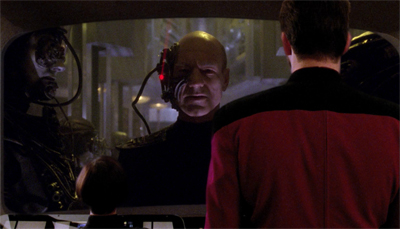

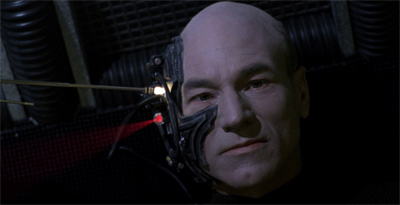
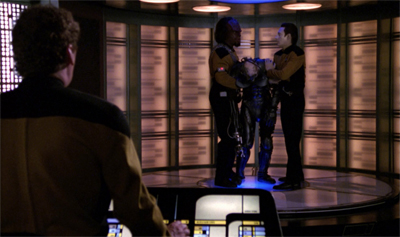

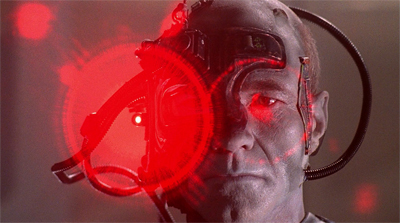
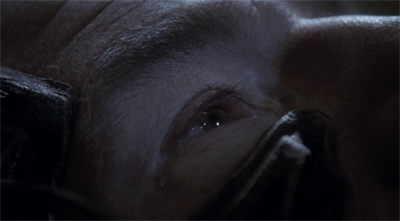




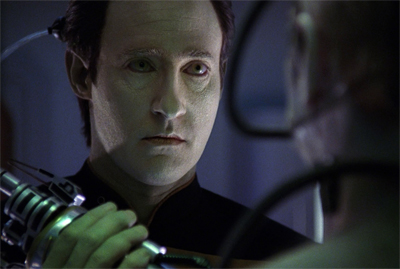
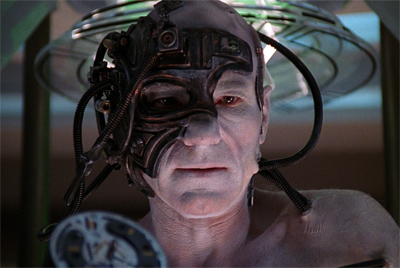
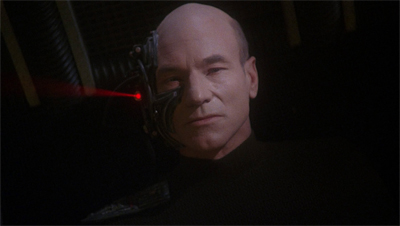

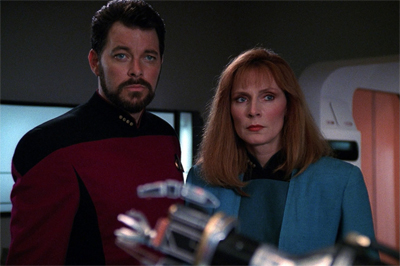


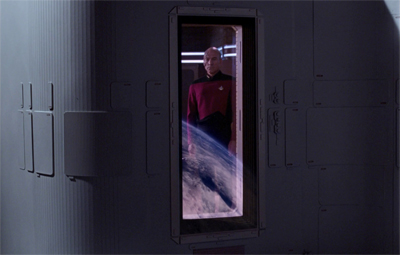

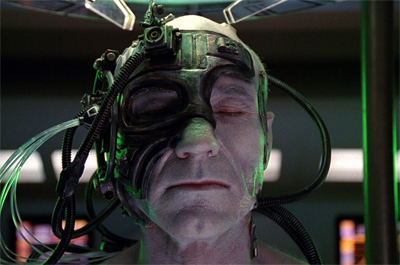





Just wanted to offer some appreciation for these amazing reviews. Very enjoyable and enlightening! Thank you!
I will just add that, although Part II feels like a letdown, its solution to the Borg problem is quite ingenious in itself. I’m not sure many writers would have come up with something so effective. In a way, the problem is that it feels so rushed. We hardly have time to process the technobabble and ideas being used.
Thanks, reader! Always glad to get any feedback! We’ll be doing all of Enterprise, some DS9 and Voyager this year, and finishing TNG hopefully next year!
It’s a nice point about the ending. It is very much the sort of conclusion that Doctor Who tends to do well, one that fits thematically, even if it’s not grounded in – as you noted – technobabble.
“Since The Best of Both Worlds, Part II was never going to end with the Borg destroying Earth, and since Star Trek: The Next Generation was never going to be a show willing to exact a dramatic cost high enough to justify victory against such overwhelming odds”
The episode was originally supposed to feature the Borg cube right above Paris, with the Enterprise battling it over the city. I think this was cut for budget reasons, not because of a conservative attitude over drama though, much like how First Contact was originally to feature like 30 cubes attacking Earth.
Anyway, how do you feel on the other Borg episodes, I Borg and the Descent two parter?
Also this episode is one of the few times I prefer the original version over the HD version, since they replace the awesome model explosion with crappy CGI that looks terrible.
I, Borg is a classic. So good that Ronald D. Moore kinda latched on to it for both Deep Space Nine and Battlestar Galactica.
I love Descent, Part I. Descent, Part II has some problems, but I like it a lot.
“I, Borg is a classic. So good that Ronald D. Moore kinda latched on to it for both Deep Space Nine and Battlestar Galactica.”
How do you mean he latched onto it?
Also agree its a classic, one of my favorite episodes, right up there with Q Who and Best of Both Worlds and First Contact. The invasive virus program was such a cool idea, it’s been copied in a lot of sci-fi, such as Mass Effect.
I like the Descent two parter as well, but was that originally intended to show the entire collective became that way or was it just one ship? I ask because I’ve seen people say both of those. If so, that would have been a rather anti-climatic way to end the Borg.
Well, the idea of an unstoppable cybernetic race stopped by a few individuals who connect with their humanity is really the heart of the reimagined Battlestar Galactica. More than that, Moore revisits the “would you commit genocide through a virus?” moral dilemma in both the final season of Deep Space Nine and in Battlestar Galactica.
I am honestly not sure what the intent was when Descent was written. The fact that there’s just one planet and just one ship would suggest that it’s not the entire Collective, even before First Contact reaffirms that. But, on the other hand, it could be that the entire Collective dissolved and this is just one branch. But, I agree, it would have been an anticlimax for the the Borg.
Ah I see. I never watched the Battlestar Galactica remake because I thought it was boring, but I’ll take your word for it.
As for Descent, rewatched it, and Hugh says at the end of the second part “we can’t return to the Collective”. I imagine that means the Collective is still at large, this was just a group.
Galactica was great. Hit some bumps in its last year, but genuinely good television. Although I much prefer DS9, if only because it feels less damn cynical.
I saw a few episodes and was bored so never continued. I’m aware it had a very hated ending that practically killed that franchise, AFAIK. But then again, I’m not a huge TV person (believe it or not, I barely watch any TV). Outside some select series (Star Trek obviously being one of them), it’s not a medium I prefer, so thus something like Battlestar Galactica isn’t instantly going to impress me.
I also notice this episode is yet another example of an alternate bridge looking far cooler than the normal bridge. Yesterdays Enterprise dark bridge (still the coolest), this battle bridge, the various alternate ones in Parallels, the Enterprise E bridge from First Contact onwards…
Oh, the aftermath scene at Wolf 359 is still a very haunting scene that stands the test of time, esp because of the Ron Jones score. I think the second part is actually underrated, I love it as much as the first part. It could have been better, but who cares
I wish I could agree with my original assessment of the episode. But after a recent re-watch, I now realize that it was rather clunky. The best aspects of “The Best of Both Worlds” was the Elizabeth Shelby and Picard’s kidnapping and assimilation. But there were decisions made for this story that left me scratching my head.
Why did the Borg only snatched Picard? They could have assimilated the entire or most of the Enterprise crew by the end of “Part I”. Why did the Borg leave the Enterprise-D behind? Why not simply destroy the ship? Many people have a problem with “Part II”. I have a problem with both parts. I think “The Best of Both Worlds” is vastly overrated. Entertaining, but overrated.
The Borg disinterest in an individual ship was established in Q Who?, and fits broadly with the show’s portrayal of them as a machine mind – the kind of organising consciousness with little tolerance for improvisation or even following a plan beyond the agreed confines of it. The plan said conquer Earth, so they set out to do that. The plan to conquer Earth involved assimilating Picard, so they did that. The plan didn’t suggest destroying the Enterprise, so they didn’t do that.